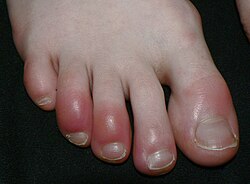Chilblains

Editor-In-Chief: Prab R Tumpati, MD
Obesity, Sleep & Internal medicine
Founder, WikiMD Wellnesspedia &
W8MD's medical weight loss NYC, sleep center NYC
Philadelphia medical weight loss and Philadelphia sleep clinics
| Chilblains | |
|---|---|

| |
| Synonyms | Pernio, perniosis |
| Pronounce | |
| Specialty | Dermatology |
| Symptoms | Redness, itching, inflammation, blisters |
| Complications | Infection, ulceration |
| Onset | Cold weather |
| Duration | 1–3 weeks |
| Types | N/A |
| Causes | Cold exposure, poor circulation |
| Risks | Raynaud's phenomenon, smoking, poor nutrition |
| Diagnosis | Clinical diagnosis |
| Differential diagnosis | Frostbite, Raynaud's phenomenon, erythromelalgia |
| Prevention | Warm clothing, avoiding cold exposure |
| Treatment | Warming, topical corticosteroids, nifedipine |
| Medication | Nifedipine, topical corticosteroids |
| Prognosis | N/A |
| Frequency | Common in cold climates |
| Deaths | N/A |

Chilblains (also known as pernio and perniosis) is a medical condition that occurs when a predisposed individual is exposed to cold and humidity, causing tissue damage. It is often confused with frostbite and hypothermia, as they share similar symptoms and environmental conditions, but chilblains is a separate condition that does not involve freezing or necessarily extreme cold.
Presentation[edit]
Chilblains presents as painful inflammation of small blood vessels in the skin, typically in response to a sudden warming from cold temperatures. The condition can cause itching, red patches, swelling and blistering on extremities, such as the hands and feet.
Causes and Risk Factors[edit]
The exact cause of chilblains is not well understood, but it's thought to be an abnormal reaction of the body to cold exposure followed by rewarming. Rewarming of cold skin can cause small blood vessels under the skin to expand more quickly than nearby larger blood vessels can handle, resulting in a bottleneck effect and the subsequent inflammation. Risk factors include:
- Poor circulation
- Family history of chilblains
- Regular exposure to cold and humidity
- Being underweight
- Certain conditions such as Raynaud's disease, lupus, and rheumatoid arthritis.
Diagnosis[edit]
Diagnosis of chilblains is typically based on the clinical presentation of symptoms and the patient's history of exposure to cold. Imaging or other diagnostic tests are usually not necessary.
Treatment[edit]
Treatment of chilblains primarily focuses on relieving symptoms and preventing the condition from recurring. Home remedies include warming the skin gently (without direct heat, which can cause burns), keeping the skin dry and moisturized, and avoiding cold exposure as much as possible. For severe or recurring cases, medical treatment may be necessary. This could include a prescription for a drug to improve circulation, topical corticosteroids to reduce inflammation, or antibiotics if an infection develops.
Prevention[edit]
Prevention is a key component in managing chilblains. This includes keeping the extremities warm in cold weather, using appropriate protective clothing, and making lifestyle changes to improve circulation such as quitting smoking or regular exercise.
See Also[edit]
References[edit]
<references/>
- "Chilblains". Mayo Clinic. Retrieved 2021-09-01.
- "Chilblains". NHS UK. Retrieved 2021-09-01.
External Links[edit]
Ad. Transform your life with W8MD's Budget GLP-1 injections from $75


W8MD offers a medical weight loss program to lose weight in Philadelphia. Our physician-supervised medical weight loss provides:
- Weight loss injections in NYC (generic and brand names):
- Zepbound / Mounjaro, Wegovy / Ozempic, Saxenda
- Most insurances accepted or discounted self-pay rates. We will obtain insurance prior authorizations if needed.
- Generic GLP1 weight loss injections from $75 for the starting dose.
- Also offer prescription weight loss medications including Phentermine, Qsymia, Diethylpropion, Contrave etc.
NYC weight loss doctor appointmentsNYC weight loss doctor appointments
Start your NYC weight loss journey today at our NYC medical weight loss and Philadelphia medical weight loss clinics.
- Call 718-946-5500 to lose weight in NYC or for medical weight loss in Philadelphia 215-676-2334.
- Tags:NYC medical weight loss, Philadelphia lose weight Zepbound NYC, Budget GLP1 weight loss injections, Wegovy Philadelphia, Wegovy NYC, Philadelphia medical weight loss, Brookly weight loss and Wegovy NYC
|
WikiMD's Wellness Encyclopedia |
| Let Food Be Thy Medicine Medicine Thy Food - Hippocrates |
Medical Disclaimer: WikiMD is not a substitute for professional medical advice. The information on WikiMD is provided as an information resource only, may be incorrect, outdated or misleading, and is not to be used or relied on for any diagnostic or treatment purposes. Please consult your health care provider before making any healthcare decisions or for guidance about a specific medical condition. WikiMD expressly disclaims responsibility, and shall have no liability, for any damages, loss, injury, or liability whatsoever suffered as a result of your reliance on the information contained in this site. By visiting this site you agree to the foregoing terms and conditions, which may from time to time be changed or supplemented by WikiMD. If you do not agree to the foregoing terms and conditions, you should not enter or use this site. See full disclaimer.
Credits:Most images are courtesy of Wikimedia commons, and templates, categories Wikipedia, licensed under CC BY SA or similar.
Translate this page: - East Asian
中文,
日本,
한국어,
South Asian
हिन्दी,
தமிழ்,
తెలుగు,
Urdu,
ಕನ್ನಡ,
Southeast Asian
Indonesian,
Vietnamese,
Thai,
မြန်မာဘာသာ,
বাংলা
European
español,
Deutsch,
français,
Greek,
português do Brasil,
polski,
română,
русский,
Nederlands,
norsk,
svenska,
suomi,
Italian
Middle Eastern & African
عربى,
Turkish,
Persian,
Hebrew,
Afrikaans,
isiZulu,
Kiswahili,
Other
Bulgarian,
Hungarian,
Czech,
Swedish,
മലയാളം,
मराठी,
ਪੰਜਾਬੀ,
ગુજરાતી,
Portuguese,
Ukrainian


